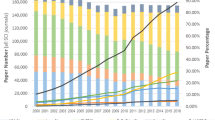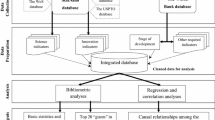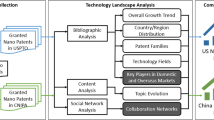Abstract
To assess worldwide development of nanotechnology, this paper compares the numbers and contents of nanotechnology patents in the United States Patent and Trademark Office (USPTO), European Patent Office (EPO), and Japan Patent Office (JPO). It uses the patent databases as indicators of nanotechnology trends via bibliographic analysis, content map analysis, and citation network analysis on nanotechnology patents per country, institution, and technology field. The numbers of nanotechnology patents published in USPTO and EPO have continued to increase quasi-exponentially since 1980, while those published in JPO stabilized after 1993. Institutions and individuals located in the same region as a repository’s patent office have a higher contribution to the nanotechnology patent publication in that repository (“home advantage” effect). The USPTO and EPO databases had similar high-productivity contributing countries and technology fields with large number of patents, but quite different high-impact countries and technology fields after the average number of received cites. Bibliographic analysis on USPTO and EPO patents shows that researchers in the United States and Japan published larger numbers of patents than other countries, and that their patents were more frequently cited by other patents. Nanotechnology patents covered physics research topics in all three repositories. In addition, USPTO showed the broadest representation in coverage in biomedical and electronics areas. The analysis of citations by technology field indicates that USPTO had a clear pattern of knowledge diffusion from highly cited fields to less cited fields, while EPO showed knowledge exchange mainly occurred among highly cited fields.















Similar content being viewed by others
References
Bacchiocchi E, Montobbio F (2004) EPO vs. USPTO citation lags. Working Paper CESPRI 161
Balconi M, Breschi S, Lissoni F (2004) Networks of inventors and the role of academia: an exploration of Italian patent data. Res Policy 33(1):127–145
Chen H, Schuffels C, Orwig R (1996) Internet categorization and search: a machine learning approach. J Visual Commun Image Represent (Digital Libraries 7), 88–102
Criscuolo P (2005) The ‘home advantage’ effect and patent families. A comparison of OECD triadic patents, the USPTO and the EPO. Scientometrics 66(1):23–41
European Commission (1997) Second European report on S&T indicators. European Commission, Brussels
Ganguli P (1998) Intellectual property rights in transition. World Patent Inform 20:171–180
Gansner E, North S (2000) An open graph visualization system and its applications to software engineering. Softw Pract Exp 30(11):1203–1233
Huang Z, Chen H, Chen Z-K, Roco MC (2004) International nanotechnology development in 2003: country, institution, and technology field analysis based on USPTO patent database. J Nanoparticle Res 6(4):325–354
Huang Z, Chen H, Yip A, Ng G, Guo F, Chen Z-K, Roco M (2003) Longitudinal patent analysis for nanoscale science and engineering: country, institution and technology field. J Nanoparticle Res 5:333–363
Huang Z, Chen H, Yan L, Roco M (2005) Longitudinal nanotechnology development (1991–2002): National Science Foundation funding and its impact on patents. J Nanoparticle Res 7:343–376
Karki MM (1997) Patent citation analysis: a policy analysis tool. World Patent Inform 19:269–272
Lukach R, Plasmans J (2001) A study of knowledge spill-overs from the compatible EPO and USPTO patent datasets for Belgian companies. Federal Office for Scientific, Technical and Cultural Affairs
Narin F (1994) Patent bibliometrics. Scientometrics 30(1):147–155
Ong T-h, Chen H, Sung W-K, Zhu B (2005) News map: a Knowledge map for online news. Decis Support Syst 39:583–597
Oppenheim C (2000) Do patent citations count? In: Cromin B, Atkins HB (eds) The web of knowledge. Information Today, Inc., Medford, pp 405–432
Quillen CD, Webster OH, Eichmann R (2002) Continuing patent applications and performance of the US patent and trademark office—extended. Federal Circuit Bar J 12(1):35–55
Roco MC (2005) International perspective on government nanotechnology funding in 2005. J Nanoparticle Res 7:707–712
Roco MC, Williams RS, Alivisatos P (2000) Nanotechnology research directions. Kluwer Academic Publishers, Dordrecht
Tolle K, Chen H (2000) Comparing noun phrasing techniques for use with medical digital library tools. J Am Soc Inform Sci 51(4):518–522
Acknowledgements
This research is supported by the following awards: National Science Foundation: “Intelligent Patent Analysis for Nanoscale Science and Engineering,” IIS-0311652; “Mapping Nanotechnology Development,” DMI-0533749; and “Worldwide Nanotechnology Development: A Comparative Study of Global Patents” CMMI-0654232. The last co-author was supported by the Directorate for Engineering, NSF. We would like to thank USPTO, EPO, and JPO for making their databases available for research.
Author information
Authors and Affiliations
Corresponding author
Rights and permissions
About this article
Cite this article
Li, X., Lin, Y., Chen, H. et al. Worldwide nanotechnology development: a comparative study of USPTO, EPO, and JPO patents (1976–2004). J Nanopart Res 9, 977–1002 (2007). https://doi.org/10.1007/s11051-007-9273-z
Received:
Accepted:
Published:
Issue Date:
DOI: https://doi.org/10.1007/s11051-007-9273-z




